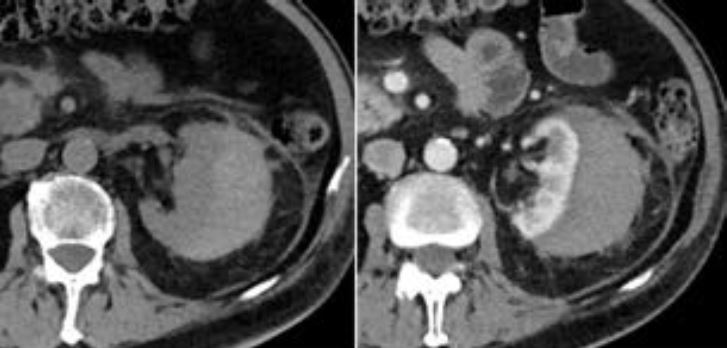ENFOQUE RADIOLÓGICO DE LAS LESIONES TRAUMÁTICAS DEL APARATO URINARIO
Palabras clave:
APARATO URINARIO, LESIONES TRAUMÁTICAS, poster, seramResumen
Objetivos Docentes
Revisión de mecanismos traumáticos, pruebas de imagen necesarias, hallazgos radiológicos, clasificación y manejo de las lesiones del aparato urinario en un paciente traumático.
Revisión del tema
LESIONES TRAUMÁTICAS RENALES
INTRODUCCIÓN
Se estima que hasta un 5% de pacientes traumáticos presentan daño renal. Se presenta principalmente en pacientes jóvenes, siendo más frecuentes en hombres; esta mayor prevalencia en el sexo masculino se atribuye al desarrollo de actividades de alto riesgo (deportes automovilísticos de alta velocidad, deportes de contacto, violencia).
Descargas
Citas
J. C. Buckley and J. W. McAninch. Selective management of isolated and nonisolated grade IV renal injuries. Journal of Urology, vol. 176, no. 6, pp. 2498–2502, 2006.
Heller MT, Schnor N. MDCT of renal trauma: correlation to AAST organ injury scale. Clin Imaging. 2014 Jul-Aug;38(4):410-7
Bonatti M, Lombardo F, Vezzali N, Zamboni G, Ferro F, Pernter P, Pycha A, Bonatti G.MDCT of blunt renal trauma: imaging findings and therapeutic implications. Insights Imaging. 2015 Apr;6(2):261-72.
Titton RL, Gervais DA, Hahn PF, Harisinghani MG, Arellano RS, Mueller PR. Urine leaks and urinomas: diagnosis and imaging-guided intervention. Radiographics. 2003 Sep-Oct;23(5):1133-47
Vaccaro JP1, Brody JM. CT cystography in the evaluation of major bladder trauma. Radiographics. 2000 Sep-Oct;20(5):1373-81.
Meng MV, Brandes SB, McAninch JW. Renal trauma: indications and techniques for surgical exploration. World J Urol 1999 Apr;17(2):71-7.
Moore EE, Shackford SR, Pachter HL, et al. Organ injury scaling: spleen, liver, and kidney. J Trauma 1989;29(12):1664–6.
Lee YJ, Oh SN, Rha SE, Byun JY. Renal trauma.RadiolClin North Am 2007;45:581–92 [ix].
Moudouni SM, HadjSlimen M, Manunta A, Patard JJ, Guiraud PH, Guille F, Bouchot O, Lobel B. Management of major blunt renal lacerations: is a nonoperative approach indicated? EurUrol 2001 Oct;40(4):409-14.
Wilkinson AG, Haddock G, Carachi R. Separation of renal fragments by aurinoma after renal trauma: percutaneous drainage accelerates healing. PediatrRadiol 1999; 29:503–505.
Elliott SP, Olweny EO, McAninch JW. Renal arterial injuries: a single center analysis of management strategies and outcomes. J Urol 2007 Dec;178(6):2451-5.
Mohsen T, El-Assmy A, El-Diasty T. Long-term functional and morphological effects of transcatheter arterial embolization of traumatic renal vascular injury. BJU Int 2008 Feb;101(4):473-7.
Knudson MM, Harrison PB, Hoyt DB, Shatz DV, Zietlow SP, Bergstein JM, Mario LA, McAninch JW. Outcomeafter major renovascular injuries: a Western trauma association multicenter report. J Trauma 2000 Dec;49(6):1116-22.
Dobrowolski Z, Kusionowicz J, Drewniak T, Habrat W, Lipczynski W, Jakubik P and Weglarz W. Renal and ureteric trauma: diagnosis and management in Poland. BJU Int 2002 May;89(7):748-51.


